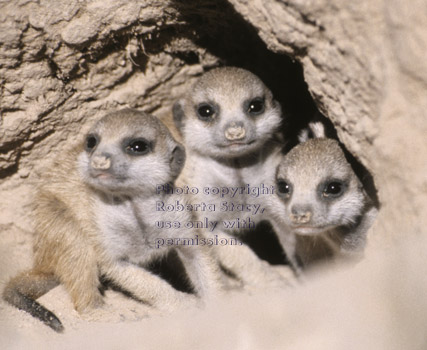Reproduction (How do meerkats make
babies?)
The average number of offspring a meerkat has is about three. Their gestation period is around eleven weeks. Both the male and female meerkat are sexually mature at the age of one. Pups (baby meerkats) are born with their eyes and ears closed and they usually reside underground with their mother for two to three weeks. Males initiate internal reproduction by fighting with the female. If the female resists his attempts to mount her, the male will grip her until she is submissive. Meerkats don’t always stay with the same mate. During mating, the male grips the female around the middle to maintain his position. Meerkats usually mate throughout the year, but mate more frequently during the warmer months when there is rain. In the wild most births are between August to March. Meerkats are dioecious meaning that they have separate sexes. Meerkats are also viviparous which means the embryo develops in the mother. Like most mammals, the mother provides the offspring with milk. Both the mother and the father have essential roles in the bringing up of the offspring. The dominant male and female in the group do most of the breeding. The offspring are weaned after about two months and are left with a babysitter when the mother goes hunting. The mother and other group members bring food to the offspring when they are old enough for solids.
 For Some Tunes click
HERE!
For Some Tunes click
HERE!
At the age of four to ten weeks the meerkat pups compete to receive prey items from the members of the group because they are learning how to hunt on their own. The group member tends to feed whichever pup is closest so when he or she gets back the pups are ready to fight for the food. After sixteen weeks the meerkat pup starts to find his or her food at his or her own risk with little aid from the older meerkats. At ten months there is the option for the young meerkat to venture out to look for a new group and start his or her new family. One question that has many people concerned is why don’t these “babysitters” breed and why do they assist other individuals to help raise their young? One supposed reason is that energetic constraints limit the capacity of female meerkats to breed successfully. Group members of both sexes help raise the young pups by guarding them at the burrow, feeding them, and acting as lookouts while the rest of the group is foraging (hunting for food). Because the offspring can’t hunt for food the helpers must meet their own needs plus the needs of the growing pup. This makes this time a very energy consuming and stressful time. There is evidence that these helpers invest extra amounts of resources in raising young. Increases in litter size are positively associated with increases in the proportion of food items that helpers give away to the pups. Reproduction is costly for the dominant female, who is stressed to find food for their growing offspring. In captivity meerkats can live up to twelve years, while in the wild meerkats can live up to ten years.
Amanda Hustad Copyright © 2007, Design by: Sunlight webdesign


